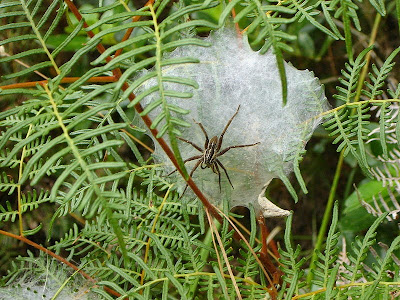In the modern world, the brachiopods are an unfamiliar group to most people. To most, they would probably not be readily distinguished from the much more abundant bivalves that they superficially resemble (a resemblance that is literally only skin deep: brachiopods and bivalves are in no way close relatives, and their internal anatomy is fundamentally different). However, this was not always the case. If one was to travel back to some point in the Palaeozoic era, one would find the situation reversed. At this time, it was the brachiopods that dominated the world's seas, while the bivalves were relegated to a minor supporting role. Their respective fortunes changed around the beginning of the Mesozoic, though whether that was because changing conditions favoured the bivalves, or whether the bivalves simply got a head start in recovering from the Rocks Fall, Everyone Dies clusterf*** that was the end-Permian extinction event, I couldn't tell you.
The fossil shown at the top of this post is one of these Palaeozoic brachiopods, a member of the family Rhipidothyrididae. Rhipidothyridids were among the earliest families of the order Terebratulida, which includes the majority of surviving brachiopods but in the Palaeozoic was just one group among many. Half a dozen genera from the Devonian period have been assigned the Rhipidothyrididae (Lee 2006). They often occur in mass assemblages, with a low diversity of other fossils (Boucot & Wilson 2004). That these assemblages represent their habits in life is indicated by the fact that the individual brachiopods in them are usually articulated; because the shells lacked a toothed hinge, the valves would soon become disassociated if transported after death.
The relationships of the rhipidothyridids are somewhat uncertain. A significant feature used in terebratulid classification is the morphology of the loop, a calcified ring at the base of the shell that provides part of the support for the lophophore in life. In some terebratulids, the loop is long and provides most of the lophophore support; in others, the loop is much shorter and lophophore support is partially taken over by free spicules embedded in the lophophore itself. However, because the loop is a quite delicate structure, its study in fossil taxa requires careful sectioning of specimens, with due consideration of the possibility of post-mortem damage. To date, this has not yet been done for the rhipidothyridids, so their loop morphology remains unknown.
REFERENCES
Boucot, A. J. & R. A. Wilson. 1994. Origin and early radiation of terebratuloid brachiopods: thoughts provoked by Prorensselaeria and Nanothyris. Journal of Paleontology 68 (5): 1002–1025.
Lee, D. E. 2006. Stringocephaloidea. In: Kaesler, R. L. (ed.) Treatise on Invertebrate Paleontology pt H. Brachiopoda (Revised) vol. 5. Rhynchonelliformea (part) pp. 1994–2018.






